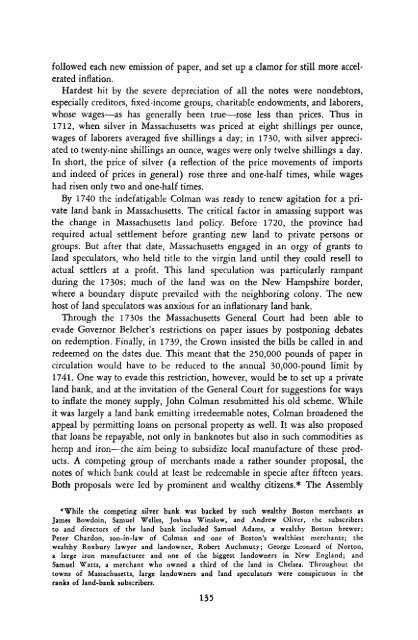Conceived in Liberty Volume 2 - Ludwig von Mises Institute
Conceived in Liberty Volume 2 - Ludwig von Mises Institute
Conceived in Liberty Volume 2 - Ludwig von Mises Institute
You also want an ePaper? Increase the reach of your titles
YUMPU automatically turns print PDFs into web optimized ePapers that Google loves.
followed each new emission of paper, and set up a clamor for still more accelerated<br />
<strong>in</strong>flation.<br />
Hardest hit by the severe depreciation of all the notes were nondebtors,<br />
especially creditors, fixed-<strong>in</strong>come groups, charitable endowments, and laborers,<br />
whose wages—as has generally been true—rose less than prices. Thus <strong>in</strong><br />
1712, when silver <strong>in</strong> Massachusetts was priced at eight shill<strong>in</strong>gs per ounce,<br />
wages of laborers averaged five shill<strong>in</strong>gs a day; <strong>in</strong> 1730, with silver appreciated<br />
to twenty-n<strong>in</strong>e shill<strong>in</strong>gs an ounce, wages were only twelve shill<strong>in</strong>gs a day.<br />
In short, the price of silver (a reflection of the price movements of imports<br />
and <strong>in</strong>deed of prices <strong>in</strong> general) rose three and one-half times, while wages<br />
had risen only two and one-half times.<br />
By 1740 the <strong>in</strong>defatigable Colman was ready to renew agitation for a private<br />
land bank <strong>in</strong> Massachusetts. The critical factor <strong>in</strong> amass<strong>in</strong>g support was<br />
the change <strong>in</strong> Massachusetts land policy. Before 1720, the prov<strong>in</strong>ce had<br />
required actual settlement before grant<strong>in</strong>g new land to private persons or<br />
groups. But after that date, Massachusetts engaged <strong>in</strong> an orgy of grants to<br />
land speculators, who held title to the virg<strong>in</strong> land until they could resell to<br />
actual settlers at a profit. This land speculation was particularly rampant<br />
dur<strong>in</strong>g the 1730s; much of the land was on the New Hampshire border,<br />
where a boundary dispute prevailed with the neighbor<strong>in</strong>g colony. The new<br />
host of land speculators was anxious for an <strong>in</strong>flationary land bank.<br />
Through the 1730s the Massachusetts General Court had been able to<br />
evade Governor Belcher's restrictions on paper issues by postpon<strong>in</strong>g debates<br />
on redemption. F<strong>in</strong>ally, <strong>in</strong> 1739, the Crown <strong>in</strong>sisted the bills be called <strong>in</strong> and<br />
redeemed on the dates due. This meant that the 250,000 pounds of paper <strong>in</strong><br />
circulation would have to be reduced to the annual 30,000-pound limit by<br />
1741. One way to evade this restriction, however, would be to set up a private<br />
land bank, and at the <strong>in</strong>vitation of the General Court for suggestions for ways<br />
to <strong>in</strong>flate the money supply, John Colman resubmitted his old scheme. While<br />
it was largely a land bank emitt<strong>in</strong>g irredeemable notes, Colman broadened the<br />
appeal by permitt<strong>in</strong>g loans on personal property as well. It was also proposed<br />
that loans be repayable, not only <strong>in</strong> banknotes but also <strong>in</strong> such commodities as<br />
hemp and iron—the aim be<strong>in</strong>g to subsidize local manufacture of these products.<br />
A compet<strong>in</strong>g group of merchants made a rather sounder proposal, the<br />
notes of which bank could at least be redeemable <strong>in</strong> specie after fifteen years.<br />
Both proposals were led by prom<strong>in</strong>ent and wealthy citizens.* The Assembly<br />
*While the compet<strong>in</strong>g silver bank was backed by such wealthy Boston merchants as<br />
James Bowdo<strong>in</strong>, Samuel Welles, Joshua W<strong>in</strong>slow, and Andrew Oliver, the subscribers<br />
to and directors of the land bank <strong>in</strong>cluded Samuel Adams, a wealthy Boston brewer;<br />
Peter Chardon, son-<strong>in</strong>-law of Colman and one of Boston's wealthiest merchants; the<br />
wealthy Roxbury lawyer and landowner, Robert Auchmuty; George Leonard of Norton,<br />
a large iron manufacturer and one of the biggest landowners <strong>in</strong> New England; and<br />
Samuel Watts, a merchant who owned a third of the land <strong>in</strong> Chelsea. Throughout the<br />
towns of Massachusetts, large landowners and land speculators were conspicuous <strong>in</strong> the<br />
ranks of land-bank subscribers.<br />
135
















